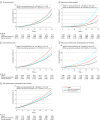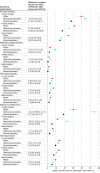Association Between Preserved Ratio Impaired Spirometry and Clinical Outcomes in US Adults
- PMID: 34905031
- PMCID: PMC8672237
- DOI: 10.1001/jama.2021.20939
Association Between Preserved Ratio Impaired Spirometry and Clinical Outcomes in US Adults
Erratum in
-
Incorrect Surname for Author.JAMA. 2022 Jan 18;327(3):286. doi: 10.1001/jama.2021.23883. JAMA. 2022. PMID: 35040903 Free PMC article. No abstract available.
Abstract
Importance: Chronic lung diseases are a leading cause of morbidity and mortality. Unlike chronic obstructive pulmonary disease, clinical outcomes associated with proportional reductions in expiratory lung volumes without obstruction, otherwise known as preserved ratio impaired spirometry (PRISm), are poorly understood.
Objective: To examine the prevalence, correlates, and clinical outcomes associated with PRISm in US adults.
Design, setting, and participants: The National Heart, Lung, and Blood Institute (NHLBI) Pooled Cohorts Study was a retrospective study with harmonized pooled data from 9 US general population-based cohorts (enrollment, 65 251 participants aged 18 to 102 years of whom 53 701 participants had valid baseline lung function) conducted from 1971-2011 (final follow-up, December 2018).
Exposures: Participants were categorized into mutually exclusive groups by baseline lung function. PRISm was defined as the ratio of forced expiratory volume in the first second to forced vital capacity (FEV1:FVC) greater than or equal to 0.70 and FEV1 less than 80% predicted; obstructive spirometry FEV1:FVC ratio of less than 0.70; and normal spirometry FEV1:FVC ratio greater than or equal to 0.7 and FEV1 greater than or equal to 80% predicted.
Main outcomes and measures: Main outcomes were all-cause mortality, respiratory-related mortality, coronary heart disease (CHD)-related mortality, respiratory-related events (hospitalizations and mortality), and CHD-related events (hospitalizations and mortality) classified by adjudication or validated administrative criteria. Absolute risks were adjusted for age and smoking status. Poisson and Cox proportional hazards models comparing PRISm vs normal spirometry were adjusted for age, sex, race and ethnicity, education, body mass index, smoking status, cohort, and comorbidities.
Results: Among all participants (mean [SD] age, 53.2 [15.8] years, 56.4% women, 48.5% never-smokers), 4582 (8.5%) had PRISm. The presence of PRISm relative to normal spirometry was significantly associated with obesity (prevalence, 48.3% vs 31.4%; prevalence ratio [PR], 1.68 [95% CI, 1.55-1.82]), underweight (prevalence, 1.4% vs 1.0%; PR, 2.20 [95% CI, 1.72-2.82]), female sex (prevalence, 60.3% vs 59.0%; PR, 1.07 [95% CI, 1.01-1.13]), and current smoking (prevalence, 25.2% vs 17.5%; PR, 1.33 [95% CI, 1.22-1.45]). PRISm, compared with normal spirometry, was significantly associated with greater all-cause mortality (29.6/1000 person-years vs 18.0/1000 person-years; difference, 11.6/1000 person-years [95% CI, 10.0-13.1]; adjusted hazard ratio [HR], 1.50 [95% CI, 1.42-1.59]), respiratory-related mortality (2.1/1000 person-years vs 1.0/1000 person-years; difference, 1.1/1000 person-years [95% CI, 0.7-1.6]; adjusted HR, 1.95 [95% CI, 1.54-2.48]), CHD-related mortality (5.4/1000 person-years vs 2.6/1000 person-years; difference, 2.7/1000 person-years [95% CI, 2.1-3.4]; adjusted HR, 1.55 [95% CI, 1.36-1.77]), respiratory-related events (12.2/1000 person-years vs 6.0/1000 person-years; difference, 6.2/1000 person-years [95% CI, 4.9-7.5]; adjusted HR, 1.90 [95% CI, 1.69-2.14]), and CHD-related events (11.7/1000 person-years vs 7.0/1000 person-years; difference, 4.7/1000 person-years [95% CI, 3.7-5.8]; adjusted HR, 1.30 [95% CI, 1.18-1.42]).
Conclusions and relevance: In a large, population-based sample of US adults, baseline PRISm, compared with normal spirometry, was associated with a small but statistically significant increased risk for mortality and adverse cardiovascular and respiratory outcomes. Further research is needed to explore whether this association is causal.
Conflict of interest statement
Figures


References
-
- Mannino DM, McBurnie MA, Tan W, et al. ; BOLD Collaborative Research Group . Restricted spirometry in the Burden of Lung Disease Study. Int J Tuberc Lung Dis. 2012;16(10):1405-1411. - PubMed
Publication types
MeSH terms
Grants and funding
- K23 HL133438/HL/NHLBI NIH HHS/United States
- R01 ES021367/ES/NIEHS NIH HHS/United States
- R01 AG023629/AG/NIA NIH HHS/United States
- R01 HL109282/HL/NHLBI NIH HHS/United States
- R01 HL109315/HL/NHLBI NIH HHS/United States
- R01 HL109284/HL/NHLBI NIH HHS/United States
- R01 HL090863/HL/NHLBI NIH HHS/United States
- IK2 RX002165/RX/RRD VA/United States
- U01 HL041642/HL/NHLBI NIH HHS/United States
- R01 HL122477/HL/NHLBI NIH HHS/United States
- R01 HL121270/HL/NHLBI NIH HHS/United States
- U01 HL041654/HL/NHLBI NIH HHS/United States
- R01 HL093081/HL/NHLBI NIH HHS/United States
- R01 ES025216/ES/NIEHS NIH HHS/United States
- U01 HL080295/HL/NHLBI NIH HHS/United States
- R21 HL153700/HL/NHLBI NIH HHS/United States
- R01 HL109319/HL/NHLBI NIH HHS/United States
- R01 HL130506/HL/NHLBI NIH HHS/United States
- U01 HL065521/HL/NHLBI NIH HHS/United States
- R21 EB027891/EB/NIBIB NIH HHS/United States
- R21 HL129924/HL/NHLBI NIH HHS/United States
- U01 HL041652/HL/NHLBI NIH HHS/United States
- U01 HL130114/HL/NHLBI NIH HHS/United States
- R21 HL121457/HL/NHLBI NIH HHS/United States
- R01 HL151421/HL/NHLBI NIH HHS/United States
- K23 HL130627/HL/NHLBI NIH HHS/United States
- U01 HL065520/HL/NHLBI NIH HHS/United States
- R01 HL109301/HL/NHLBI NIH HHS/United States
- R01 AG028050/AG/NIA NIH HHS/United States
- R01 HL077612/HL/NHLBI NIH HHS/United States
- R01 NR012459/NR/NINR NIH HHS/United States
LinkOut - more resources
Full Text Sources
Medical
Research Materials

